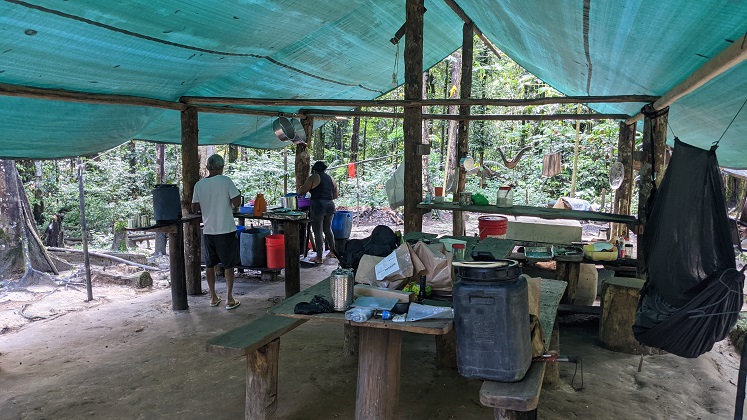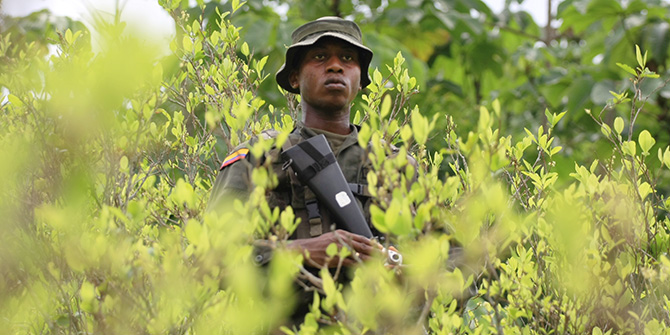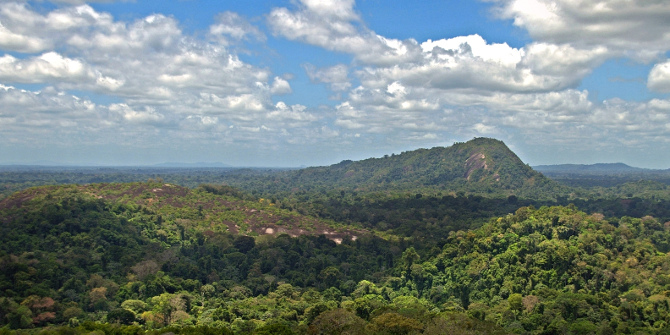Up to 12 000 informal miners, known as garimpeiros, still operate in this Caribbean country. Between five and ten tons of gold are smuggled outside the territory each year despite the pressure from French authorities. Understanding what factors make these miners resilient was the object of research led by François-Michel Le Tourneau (CNRS).
Lea este artículo en español
French Guiana, a French overseas collectivity located on the Northern coast of South America, has a long history of gold exploration by small-scale miners that started by the mid-19th century. Gold profitability was low during the 1960s and 1970s. But this activity started being widely practised again in the mid-1990s, mainly under the influence of Brazilian small-scale gold miners who were encountering more difficulties expanding at home. These miners are known as garimpeiros.
At first, this new gold rush could use the relatively accommodating rules in vigour in French Guiana. But things started to change in the early 2000s, when the French mining legislation became stricter in overseas territories and when the French authorities began to act more aggressively against what was now denounced as a clandestine activity undertaken by illegal immigrants. French military police forces (Gendarmerie) started to stage operations against the garimpeiros in 2002, but they had not enough means to curb the phenomenon. From 2008 on, the French Army was then involved in supporting the police, and with these reinforcements, the chase for illegal placers, camps or pits became much more intense, and the pressure put on illegal miners increased.
In 2018, these operations were renewed, but up to 12 000 garimpeiros still operate in French Guiana. Between five and ten tons of gold are smuggled outside the territory each year, amounting to losses between 250 to 500 million euros. Therefore, the resilience of Brazilian gold miners in front of the operations aimed at crushing them is impressive. How can it be explained?
French Guiana covers about 86 000 km², an almost entirely dense Amazonian rainforest and most of the territory is devoid of roads and only accessible by helicopter or canoes equipped with outboard motors. This requires skilled pilots to navigate dozens of rapids and waterfalls. The garimpeiros can easily play hide and seek and evade police operations, especially because there are few operational forward bases that the Army and the police can operate from. Areas are swept and cleaned by temporary operations. The French government has only about 500 soldiers and military police members being available to operate in the forest on a daily basis, so soon after they leave, the gold miners can reorganize their business and supply lines and start the exploration again.
Other factors play out as well. Brazilian gold miners are very skilled to respond to the pressure by French authorities by increasing their flexibility and reducing fixed production costs. The authorities mostly aim at destroying their equipment and supplies, in an effort to break them financially, but the whole business of the garimpo relies on an extensive network of small entrepreneurs, tightly knitted together by mutual credit and debts, which acts with solidarity and where the ruin of one opens a market niche that another one will eagerly take on. Most salaries or profits are only paid when gold is actually produced in this system. Bosses then face few expenses if they have to hold on to their activity and hide their material because the police are near, which can sometimes last for days or weeks. They can hibernate and stay low until circumstances are better.
Most salaries or profits are only paid when gold is actually produced in this system
As cost-killers of the formal economy would, the garimpeiros are also experts at reducing other costs. They use cheap Chinese motors, smuggled from Suriname mostly and easy to replace. The garimpeiros also hide their equipment and supplies in several different hideouts so they won’t lose everything if their camp is spotted and invaded. Also, the increasing risk taken by suppliers to convey everything that is needed for the exploration (especially food and gasoline for the motors) is compensated by inflation in their prices. When you can sell a gallon of fuel ten times the price you bought it, it matters less if one out of three of your shipments is intercepted.
But all these economic and organizational mechanisms are not enough to justify the resilience of Brazilian garimpeiros to French authorities’ pressure. The social and cultural universe of the garimpo is, I argue after an extensive research, also an important –and perhaps determining– factor.
A work pattern extended throughout the Amazon
The garimpo appeared in Brazil during the colonial era, as a response to the crown of Portugal’s establishment of a royal monopoly on extracting diamonds and gold. It thus always has been a clandestine activity where the rule was to escape pressure by the authorities while at the same time opening placers, smuggling in the goods necessary for their operation and smuggling out the production.
The miners who work in French Guiana follow the same system that works throughout the Brazilian Amazon. 95% of illegal gold miners operating in French Guiana’s forests are Brazilian. Many of them have also operated in other areas in Brazil or in Suriname (also quite dominated by Brazilian miners, but to a lower proportion). More importantly, all norms and rules that are present in French Guiana’s working areas are equal to what is practised in Brazil. This includes the repartition of the production between the workers, who generally share 30% and the boss, who receives 70%.
Bosses provide all that is necessary to make the camp and the place running, paying the cook’s salary, providing food, fuel, motors, etc… The relationships between workers and bosses are framed as a “society” in which and they all contribute (workers with their work, bosses with their capital) and where there is no subordination (workers are free to leave whenever they please, and workers are not paid salaries or wages, but a share of the production), or other social norms (especially regarding acceptable conducts and their enforcement).

Most of the norms and the social organization that are seen today are as old as the garimpo is and this contributes to explaining the garimpeiros resilience in French Guiana as well as in Brazil. This community can rely on a time-tested social and cultural universe that provides all the ingredients that are necessary to maintain their trade under pressure, among their flexibility, solidarity, organization, and social horizontality.
Despite strong pressure by the authorities, this research sheds another light on the persistence of an illegal activity and highlights how the contributing factors of its resilience are not limited to economic gains and opportunities but include broader social and cultural components. This might not be good news for the French government. Dealing with the centuries of experience in resisting (mostly pacifically) and evading the State’s pressure that is ingrained within the “garimpo system” might prove harder than pushing a few thousands of illegal Brazilian immigrants out of French Guiana.
Also, these results can offer new insights about the resilience of other hard-resisting illegal activities in the Americas such as coca plantation or illegal timber harvesting. Taking into account the universe in which these are embedded instead of focusing only on the product or its economics might lead to new and more efficient ways of addressing these realities.
Notes:
• The views expressed here are of the authors rather than the Centre or the LSE
• Please read our Comments Policy before commenting
• Banner image: Rafa from Brazil / (CC BY-NC-SA 2.0)





